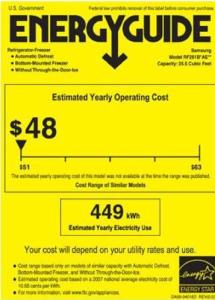When was the last time you bought a refrigerator? I ask because it's important – but not because I care about your kitchen. Promise.
There's a trick that happens when you buy a frig that's important. So even if you're a “services” person instead of a “products” person, you can still learn this lesson.
Options for Pricing your Services
Most people, when we're talking about services, create a rate for their hourly work. They do it because this is what people ask about.
“What's your hourly rate?”
We hear it all the time.
Some people get fancier. They create a rate card.
- Doing something: X dollars / hour
- Doing something else: Y dollars / hour
- Doing something harder: Z dollars / hour
This is clearly better than a single number. And it's the core of how most larger companies manage their service pricing.
An alternative, taking into account a lot of history and experience on certain kinds of tasks, is fixed-based pricing.
- Doing something: x dollars
- Doing something else: y dollars
- Doing something harder: z dollars
And if you want to get fancier, you can tie the price to value (creating a value-based fixed rate card).
But I want to introduce you to another trick. A different option.
One I learned at Best Buy when buying a refrigerator. (Yes, I take pricing lessons from everywhere.)
First, let's buy a car
Before I tell you my trick, let's talk about a car purchase.
If you step onto a lot, you're likely going to talk to someone. And they're going to ask you questions (if they're good).
What they're trying to do is get a handle on where you're anchored and where you're not. They're trying to understand what they have to work with.
One of the most common anchors that happens on the car lot relates to price.
They say, “Do you have a budget in mind?”
You say, “I'm flexible but I don't want to get crazy.”
They say, “Well, how about this car (and show you something that's $35,000)?”
You reply, “I'm trying to stay closer to the high 20's.”
You think you're getting to the end, but they're just getting started. Because once they know your range (like high 20's), they're going to introduce you to a more realistic (but complicated) way to think about price.
See, the sticker price is only a PROXY of the real price of the car.
Compare two cars, one selling for 28k and another for 30k.
But once you understand that the car selling for 28k will likely have more expensive repairs, it's REAL cost is much higher. Higher than the car selling for 30k.
Or consider not the repair cost, but the cost to insure. The 28k car may cost you 150% of the 30k car, which might make the cost differential as low as $300-400.
They won't draw you a chart, but the math they're introduce you to goes like this:
STICKER + # of REPAIRS + $ of REPAIRS + $ INSURANCE = TOTAL COST
And what they'll ask you to consider is a car that may have a higher sticker but a lower total cost.
Have you ever experienced this?
Stepping into Best Buy
Best Buy makes this much easier to understand when you're buying a refrigerator.
They have two numbers for you to consider:
- The sticker price
- The cost to run it (on your electricity bill) for a year
 When you add these two together, the new total can really distinguish one frig from another.
When you add these two together, the new total can really distinguish one frig from another.
And sometimes the cheaper frig is way more expensive (even in a single year) than one slightly more expensive.
If you buy a frig that costs $800 but has a $200 expected cost to run for a year, it's going to cost you way more than buying a $900 frig that costs $48 a year to run. And it gets even worse for the other frig every year after the first.
Applying this to the Price of your Services
Clients show up wanting their website to do a job for them. We're the ones that have to translate that into a set of features that deliver it.
And almost always, there are several ways to design the features that will deliver it.
More often than not, we make that choice either because it's easier for us (as developers) or because we're constrained (in time) by a customer's budget.
But how often do you stop and educate the client?
I have had to have this conversation more than once.
I understand you have a budget that feels pretty fixed, and I can certainly create this feature for you inside of that budget. However, you should be aware of the long-term cost that this particular approach will mean – for you and your team. Because if I create it this way (to keep your project under budget), the result will be that you'll have to have your team take care of these items. You'll also have the cost of managing this infrastructure.
Alternatively, we could use a different approach which will have a lot less long-term cost and eliminate your team's need to manage much. But it changes the budget because it means more up front development.
Some of you already do this. Well done. I congratulate you.
But a lot more of the folks I talk to simply don't have the conversation at all. And you're who I want to challenge.
People are smart enough to understand this trade-off if you explain it to them. They simply need to be educated.
And when you do, you'll write better code and get paid for it.
All because of a lesson you can learn buying a refrigerator at Best Buy.

